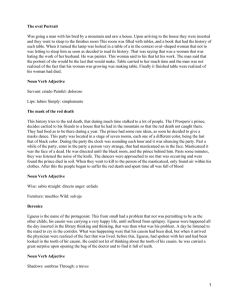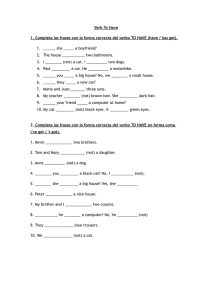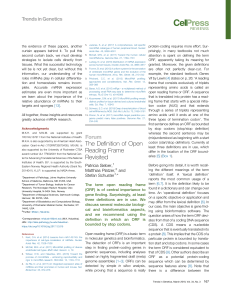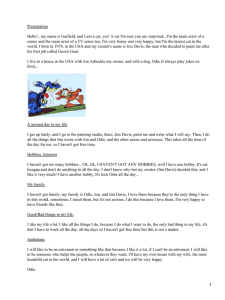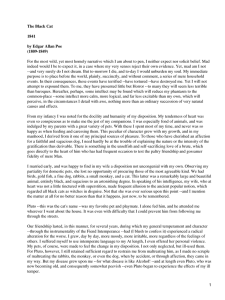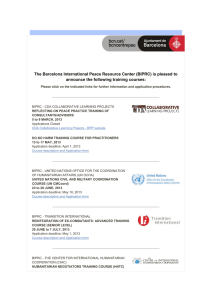FUNCTIONS OF CLASS Ck WITHOUT DERIVATIVES
Anuncio
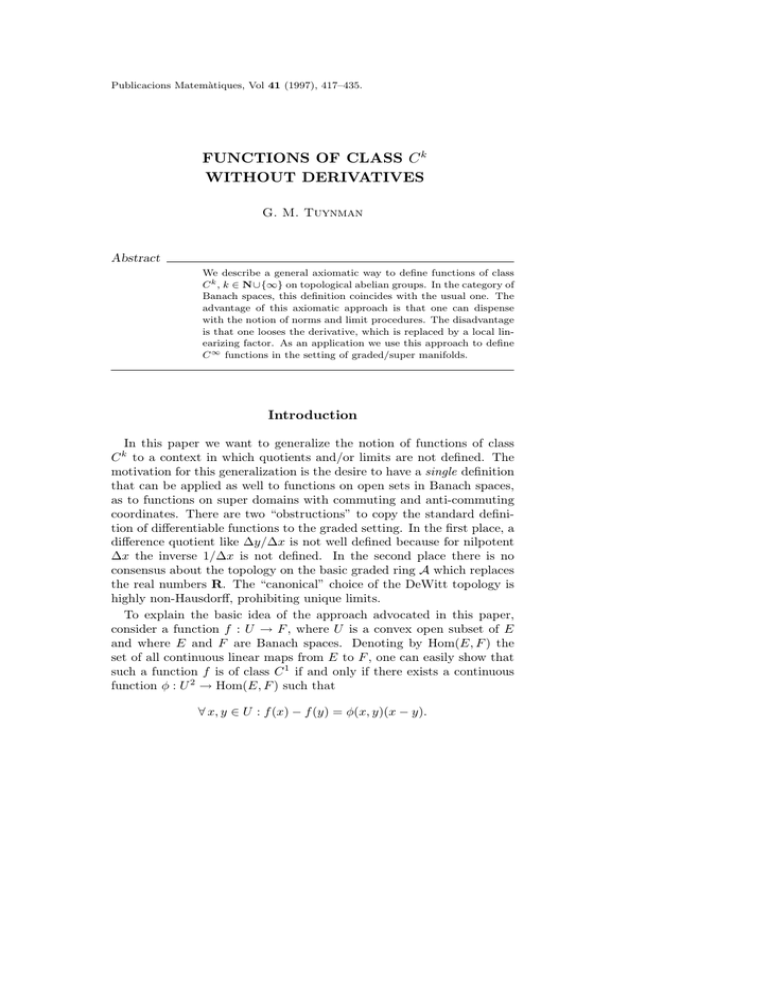
Publicacions Matemàtiques, Vol 41 (1997), 417–435.
FUNCTIONS OF CLASS C k
WITHOUT DERIVATIVES
G. M. Tuynman
Abstract
We describe a general axiomatic way to define functions of class
C k , k ∈ N∪{∞} on topological abelian groups. In the category of
Banach spaces, this definition coincides with the usual one. The
advantage of this axiomatic approach is that one can dispense
with the notion of norms and limit procedures. The disadvantage
is that one looses the derivative, which is replaced by a local linearizing factor. As an application we use this approach to define
C ∞ functions in the setting of graded/super manifolds.
Introduction
In this paper we want to generalize the notion of functions of class
C k to a context in which quotients and/or limits are not defined. The
motivation for this generalization is the desire to have a single definition
that can be applied as well to functions on open sets in Banach spaces,
as to functions on super domains with commuting and anti-commuting
coordinates. There are two “obstructions” to copy the standard definition of differentiable functions to the graded setting. In the first place, a
difference quotient like ∆y/∆x is not well defined because for nilpotent
∆x the inverse 1/∆x is not defined. In the second place there is no
consensus about the topology on the basic graded ring A which replaces
the real numbers R. The “canonical” choice of the DeWitt topology is
highly non-Hausdorff, prohibiting unique limits.
To explain the basic idea of the approach advocated in this paper,
consider a function f : U → F , where U is a convex open subset of E
and where E and F are Banach spaces. Denoting by Hom(E, F ) the
set of all continuous linear maps from E to F , one can easily show that
such a function f is of class C 1 if and only if there exists a continuous
function φ : U 2 → Hom(E, F ) such that
∀ x, y ∈ U : f (x) − f (y) = φ(x, y)(x − y).
418
G. M. Tuynman
Although φ(x, y) is not necessarily unique, the diagonal φ(x, x) is unique:
it is the (Fréchet) derivative of f .
What we will do is take this theorem and turn it into the definition
for functions of class C 1 ; the definition of functions of class C k then
is by induction. This idea is not new and can be traced back at least
to Caratheodory ([Ca]). Our generalization is to allow E and F to
be any abelian topological group, not necessarily Banach spaces. In
this generalization, one looses an important property of differentiable
functions: the derivative. As said above, for functions f of class C 1
defined on Banach spaces, the derivative can be defined as the diagonal
φ(x, x), which is unique. In the general context of abelian topological
groups, even the diagonal need not be unique and thus we cannot speak of
a properly defined derivative. This treatement is far more general than
needed for an intrinsic definition of graded manifolds, but since there
is strictly no more effort involved, we could not resist the temptation.
Moreover, it helps focussing the attention on the essential ingredients.
To outline the contents of this paper, in Section 1 we give the main
definition of our approach to functions of class C k , whereafter in Section 2 we prove some properties of the functions so defined. Finally in
Section 3 we apply our method to the setting of graded vector spaces.
1. The main definitions
Definition 1.1. A cat is a category C of abelian groups, stable under
direct products, with the following properties. In the first place each object E ∈ C has a topology for which addition is a continuous operation.
In the second place, for every two objects E, F ∈ C there exists a third
object Shom(E, F ) ∈ C consisting of continuous homomorphisms from
E to F . The elements of Shom(E, F ) will be called smooth homomorphisms.
Remark 1.2. The fact that Shom(E, F ) is an object in C implies that
it has a topology for which addition of homomorphisms is continuous.
Examples 1.3. (i) Let CV denote the category of normed vector
spaces (over R or C). We define Shom(E, F ) to be the set of all continuous linear maps (over R or C) from E to F , equipped with the operator
norm. Since addition of homomorphisms is continuous in this norm, we
conclude that Shom(E, F ) ∈ CV and that CV is a cat. An interesting
subcategory of CV is CB in which all objects are Banach spaces; CB is
also a cat.
(ii) More generally, let CA be a category of abelian groups in which
Functions of class C k without derivatives
419
each object has a topology for which addition is continuous. We
equip Hom(E, F ) with the weak∗ -topology, and we define the sets
Shom(E, F ) ⊂ Hom(E, F ) to consist of all continuous homomorphisms from E to F , equiped with the induced topology. It turns
out that addition of homomorphisms is continuous in this topology, so CA becomes a cat.
(iii) A variation on the previous example is a category CM of modules
over a commutative ring A (with A belonging to CM ), all equipped
with a topology in which the bi-additive operations of addition
and multiplication by elements of A are continuous. Here we
define Shom(E, F ) to be the A-module of all continuous A-module
homomorphisms from E to F , equipped with the (induced) weak∗ topology. The reader can easily verify that Shom(E, F ) belongs
to CM and thus that these definitions turn CM into a cat.
Remark 1.4. The cat CV of normed vector spaces over C is an
example of a cat in which Shom(E, F ) does not consist of all continuous
(additive) homomorphisms.
Remark 1.5. The example CB of Banach spaces cannot be extended
in any natural way to Fréchet spaces since the set of all continuous
morphisms between two Fréchet spaces is in general not again a Fréchet
space.
Discussion 1.6. What we now propose to do is to define sets
C k (U, F ), k ∈ N ∪ {∞} of functions of class C k defined on a subset
U ⊂ E to F , E and F objects in a fixed cat. More precisely, we will
define the whole family
Fk = {C k (U, F ) | F ∈ C
and ∃E ∈ C : U ⊂ E}
at the same time, i.e., we will define C k (U, F ) for all F and all subsets
U in any E at the same time.
Definition 1.7. Given a function f : U → F , a (local) linearizing
factor for f on U is a pair (V, φ) with V ⊂ U open in U and φ : V 2 →
Shom(E, F ) satisfying
∀ x, y ∈ V : f (x) − f (y) = φ(x, y)(x − y).
Nota Bene 1.8. We do not require the sets U ⊂ E in C k (U, F ) to be
open. In most applications one will restrict attention to open subsets,
420
G. M. Tuynman
but in the present axiomatic approach it is nowhere needed that they are
open. On the other hand, the domain of definition of a local linearizing
factor is always supposed to be open within U .
Definition 1.9. The families Fk , k ≥ 0 are defined by the conditions:
(C0) C 0 (U, F ) is the set of all continuous functions U → F ;
(C1) f ∈ C k (U, F ), k > 0 if and only if f ∈ C 0 (U, F ) and if there exists
a family (Vi , φi ) of linearizing factors for f such that ∪i Vi = U
and φi ∈ C k−1 (Vi2 , Shom(E, F ));
(C2) Fk is maximal with respect to (C1).
Remarks 1.10. (i) Condition (C1) says that a continuous function
f is of class C k if and only if there exist local linearizing factors for
f of class C k−1 . Note that we explicitly do not require that the local
linearizing factors φ in property (C1) are unique.
(ii) Property (C2) should be interpreted in the following way: if
k (U, F )} is another family satisfying property (C1), then
Fk = {C
k (U, F ) ⊂ C k (U, F ).
necessarily for all F and all U ⊂ E we have C
Of course property (C2) is unnecessary for k = ∞ since then the
recursion with respect to k ends at C 0 .
(iii) It follows immediately from the definitions that we have the inclusions
C 0 (U, F ) ⊃ · · · ⊃ C k (U, F )
⊃ C k+1 (U, F ) ⊃ · · · ⊃ ∩ C k (U, F ) ⊃ C ∞ (U, F ).
k∈N
The reader should be warned however that the inclusion ∩k∈N C k (U, F ) ⊂
C ∞ (U, F ) is not automatic (if true at all) due to the non-uniqueness of
the linearizing factors φ.
Example 1.11. Consider the category CV of normed vector spaces
(Example 1.3.(i)), let f ∈ C k (U, F ) be a function of class C k (k ≥ 1) on
an open subset U ⊂ E in our axiomatic setting and define the function
f : U → Shom(E, F ) by:
f (x) = φ(x, x),
where φ is a local linearizing factor for f defined in x. Since the function φ
is of class C k−1 , it is in particular continuous and hence f is continuous.
We claim that the function f is well defined, i.e., does not depend upon
a choice for φ but is uniquely defined by f . To see this, suppose that
Functions of class C k without derivatives
421
are both local linearizing factors for f . It follows that
(V, φ) and (V , φ)
for x ∈ V ∩ V , all h ∈ E sufficiently small and all 0 < t < 1 we have:
+ th, x))(h) = 0.
(φ(x + th, x) − φ(x
The result now follows by taking the limit t → 0 and using the continuity
Finally we claim that f is the standard Fréchet derivative
of φ and φ.
of the function f . For this we compute:
||f (x + h) − f (x) − f (x)h||
||φ(x + h, x)h − φ(x, x)h||
=
||h||
||h||
≤ ||φ(x + h, x) − φ(x, x)||.
Again the result follows because of the continuity of φ. What we have
shown is that a function f which is of class C k in our axiomatic setting,
is of class C 1 in the ordinary sense. But then it follows immediately by
induction that f is of class C k in the ordinary sense (the case k = ∞
included).
If we restrict our attention to the cat CB , we can easily show the
converse, i.e., that a function which is of class C k in the ordinary sense
is also of class C k in our axiomatic sense. For this, let f be a continuous
function of class C k in the ordinary sense defined on an open subset
U ⊂ E and define the function φ by:
φ(x, y) =
1
f (sx + (1 − s)y) ds,
0
where f is the ordinary Fréchet derivative of f . This integral is well
defined for any function f defined on an open convex set and taking
values in a Fréchet space, and thus in particular for this f which takes
values in a Banach space. It follows immediately that φ is a (local) linearizing factor of class C k−1 for f . Since any open U can be covered
by convex open subsets, f is of class C k in our axiomatic setting. Note
that this argument also shows that in the cat CB one has the equality ∩k∈N C k (U, F ) = C ∞ (U, F ) in the axiomatic approach (use property (C2), or the recursion argument explained below).
Remark 1.12. Let E be a Banach space and let M ⊂ E be an embedded submanifold of class C , ≤ ∞. A little reflection will show that,
due to the local nature of the linearizing factors, the axiomatically defined sets C k (M, F ), k ≤ correspond exactly to the set of C k functions
f : M → F in the usual sense.
422
G. M. Tuynman
The recursion argument. An axiomatic definition of functions of
class C k is very nice, but without interest if one cannot use it to prove
propositions concerning such functions. In our axiomatic setting, the
main tool to use in proofs concerning properties of functions of class C k
is the recursion argument which we will now explain.
If f : U → F is a function of class C k , it defines a whole tree of
continuous functions: at each branching level, the number of branches is
determined by the number of local linearizing factors. The continuous
linearizing factors themselves define the next level of branching. For any
k ∈ N ∪ {∞} the tree is of length k + 1.
Now suppose that we have such a tree of continuous functions of length
k + 1, each level consisting of local linearizing factors for the functions
of the preceding level. We claim that the functions of level i are of class
C k−i . For suppose the claim is false, then we could add the continuous
k−i still
functions of level i to the spaces C k−i and obtain bigger spaces C
satisfying property (C1). Since this contradicts the maximality (C2), the
conclusion follows. (N.B. If k < ∞, the tree is of finite length k + 1 and
a simple induction argument on i will also suffice.)
Now suppose we want to prove that a given continuous function f = f0
is of class C k . According to the above argument, it suffices to find a tree
of continuous functions of length k+1 in which each level consists of local
linearizing factors for the continuous functions of the preceding level. In
some cases the construction of such a tree can be explicit, but in most
cases the construction will be by induction on the level i. In any case we
will say that we use the recursion argument to prove that f is of class
Ck.
2. Some properties of C k (U, F )
Proposition 2.1. If C is a cat and k ∈ N ∪ {∞} then:
(i) All constant functions belong to C k (E, F ),
(ii) Shom(E, F ) ⊂ C k (E, F ),
⊂ U , then f ∈ C k (U
, F ),
(iii) If f ∈ C k (U, F ) and U
|U
(iv) C k (U, F ) is an abelian group under pointwise addition of functions.
Proof: (i) The constant functions certainly are continuous. The result
then follows from the recursion argument, taking at every next level the
zero function on the whole of U .
(ii) If f ∈ Shom(E, F ), then it is continuous by definition of Shom.
Taking for φ the constant function φ(x, y) = f on U and taking at each
next level the zero function, the result follows by the recursion argument.
Functions of class C k without derivatives
423
(iii) Taking restrictions certainly preserves continuity. For f ∈ C k (U, F )
there exist local linearizing factors (V, φ) of class C k−1 . If fr = f|U , we
define φr by φr = φ|(V ∩U)2 . The result follows again by the recursion
argument.
(iv) Since addition is continuous, it follows that C 0 (U, F ) is an abelian
group under pointwise addition of functions. For g, h ∈ C k (U, F ) there
exist (V, χ) and (V, θ), local linearizing factors for g and h of class C k−1 .
By taking pairwise intersections, we may indeed assume that the domains
of definition for φ and χ coincide. This enlarges the family of local
linearizing factors for g and h, but does not affect the smoothness class
by the result (iii). If the function f ∈ C 0 (U, F ) is defined as f = g + h,
we define the local linearizing factor (V, φ) by φ = χ + θ. The result now
follows by the recursion argument.
Remark 2.2. The result (ii) of the above proposition justifies our
name for the elements of Shom(E, F ): all its elements are homomorphisms of class C ∞ .
Discussion 2.3. The next question of interest concerning functions
of class C k is whether this property is stable under composition of functions. Since this can not be done without some additional hypotheses
concerning the topology of the spaces Shom(E, F ), we introduce several
conditions on these topologies.
Notations 2.4. For convenience sake, we will denote by C −1 (U, F )
the set (abelian group) of all
nset-theoretic maps φ : U → F . Associated
to any n-additive map
Ψ
:
i=1 Fi → F0 we will define n-additive maps
Ψj : Hom(E, Fj ) × i=j Fi → Hom(E, F0 ) by the formula:
Ψj (f1 , . . . , fj−1 , φj , fj+1 , . . . , fn )(e)
= Ψ(f1 , . . . , fj−1 , φj (e), fj+1 , . . . , fn ).
n
To any map Ψ : i=1 Fi → F0 we will associate a map Ψ : i C −1 (U, Fi ) →
C −1 (U, F0 ) by:
Ψ (φ1 , . . . , φn )(e) = Ψ(φ1 (e), . . . , φn (e)).
For any space E ∈ C we define the canonical injections ι : C −1 (U, F ) →
C −1 (U × E , F ) by:
(ι(f ))(x, e ) = f (x).
We also define the maps ω : C −1 (U, F ) × C −1 (U, F ) → C −1 (U, F × F )
(concatenation at the target space) by:
(ω(f, f ))(x) = (f (x), f (x)).
424
G. M. Tuynman
Finally we define the maps L, R : Hom(E, E) → Hom(Hom(E, E),
Hom(E, E)) of left and right multiplication by:
L(A)(B) = AB
R(A)(B) = BA.
Remark 2.5. The maps Ψj should be seen as something like the
partial derivatives of the n-additive map Ψ. For n = 1 the map Ψ1 is
just the restriction of Ψ to homomorphisms.
Definition 2.6. Let C be a cat and let Ψ : Gi → Hom(E, F ) be
a map in which each Gi is either an object in C or the full set of homomorphisms between two objects in C. Since we do not require any
Hom(E , F ) to carry a topology, continuity of Ψ is not defined. Nevertheless, we will say that Ψ is continuous if the following two conditions
are satisfied:
(i) if we take in the domain of definition of Ψ only smooth homomorphisms, then the image is also a smooth homomorphism, and
(ii) when restricted to smooth homomorphism spaces, Ψ is continuous.
Remark 2.7. Restriction to smooth homomorphism spaces in condition (ii) above means that all (restricted) Gj belong to the cat C, as
does the target space Shom(E, F ).
Definitions 2.8. We now present some conditions on the topology of
the spaces Shom in a cat C with generic objects E, E , F , F and G.
(T-ι) All canonical injections ι : Hom(E, F ) → Hom(E × E , F ) are
continuous.
(T-ω) All canonical isomorphisms ω : Hom(E, F ) × Hom(E, F ) →
Hom(E, F × F ) are continuous.
(T-M) All canonical multiplications M : Shom(F, G) × Shom(E, F ) →
Shom(E, G) (M(A, B) = A ◦ B = AB) are continuous.
(T-LR) The maps L, R : Shom(E, E) → Shom(Shom(E, E), Shom(E, E))
are continuous.
(Tn ) For all continuous n-additive maps Ψ satisfying a predefined set
of algebraic conditions, the associated maps Ψj , j = 1, . . . , n are
continuous and satisfy the same set of algebraic conditions.
Functions of class C k without derivatives
425
Implicit in T-LR are the assumptions that for A ∈ Shom(E, E) the maps
L(A) and R(A) preserve Shom(E, E) ⊂ Hom(E, E) and that they are
smooth.
Examples 2.9. The cats CA , CB , CM and CV of Example 1.3 all
satisfy T-ι, T-ω, T-M and Tn for all n ∈ N. For the cat CA , and for the
cats CB and CV over R, there are no additional algebraic conditions in
Tn . For the cats CB and CV over C the additional algebraic condition is
n-linearity over C. (N.B. A continuous additive map is R-linear, but not
necessarily C-linear.) Likewise, for the cat CM the algebraic condition is
to be n-linear over the ring A.
Nota Bene 2.10. In the sequel we will never mention again the set
of algebraic conditions alluded to in condition Tn . However, whenever
we invoke this condition, it should be understood that the n-additive
map in question should satisfy these unmentioned additional algebraic
conditions. This concerns in particular the maps ι, M, L, R and ω of
conditions T-ι, T-M, T-LR and T-ω.
Remark 2.11. If a cat C satisfies T1 , then left composition of a
smooth homomorphism with a continuous homomorphism will be a
smooth homomorphism. It follows that there cannot be a big difference between continuous homomorphisms and smooth homomorphisms.
Moreover, the conditions T1 and T-M, although not the same, are very
close. If the sets Shom(E, F ) consist of all continuous morphisms, then
T-M implies T1 .
Lemma 2.12. Let C be a cat satisfying T1 and let Ψ : F1 → F0 be a
continuous homomorphism. Then Ψ : C k (U, F1 ) → C k (U, F0 ).
Proof: Since Ψ is continuous, the result is certainly true for k = 0.
For f ∈ C k (U, F ), let φ be a local linearizing factor of class C k−1 . It
follows that Ψ1 ◦ φ is a local linearizing factor for Ψ ◦ f . The result now
follows by the recursion argument and T1 .
Remark 2.13. The above lemma should be interpreted as saying that,
if f : U → F1 is of class C k , then Ψ ◦ f : U → F0 is also of class C k , i.e.,
as saying that left composition with a continuous homomorphism does
not alter the smoothness class of a function. A similar interpretation
holds for the next lemmas.
426
G. M. Tuynman
Lemma 2.14. If C satisfies T1 and T-ι, then ι : C k (U, F ) → C k (U ×
E , F ).
Proof: The result is true for k = 0 since the canonical projection
E × E → E is continuous (E × E has the product topology). For
f ∈ C k (U, F ), let (V, φ) be a local linearizing factor of class C k−1 .
According to the case k = 0 we have the canonical injection ι̂ :
C 0 (V 2 , Shom(E, F )) → C 0 ((V × E )2 , Shom(E, F )). Moreover, by Tι the map ι̌ : Shom(E, F ) → Shom(E × E , F ) is continuous. A simple
calculation then shows that the map ι̌ (ι̂(φ)) is a continuous local linearizing factor for ι(f ) on V × E . We now can start the induction
needed for the recursion argument because by Lemma 2.12 we know how
to deal with ι̌ and by the above argument we know how to deal with
ι̂(φ). Application of the recursion argument finishes the proof.
Lemma 2.15. If C satisfies T1 and T-ω, then
ω : C k (U, F ) × C k (U, F ) → C k (U, F × F ).
Proof: By definition of the product topology, the result is true for
k = 0. For f ∈ C k (U, F ) and f ∈ C k (U, F ) let (V, φ) and (V, φ ) be
local linearizing factors of class C k−1 . As in the proof of Lemma 2.1.(iv),
we may assume that the domains of definition of φ and φ coincide.
According to the case k = 0 we have the map ω̂ : C 0 (V 2 , Shom(E, F )) ×
C 0 (V 2 , Shom(E, F )) → C 0 (V 2 , Shom(E, F ) × Shom(E, F )). Moreover,
by T-ω the map ω̌ : Shom(E, F ) × Shom(E, F ) → Shom(E, F × F ) is
continuous. A simple calculation then shows that the map ω̌ (ω̂(φ, φ )) is
a continuous local linearizing factor for ω(f, f ) on V . We now can start
the induction needed for the recursion argument because by Lemma 2.12
we know how to deal with ω̌ and by the above argument we know how
to deal with ω̂(φ, φ ). Application of the recursion argument finishes the
proof.
let Ψ :
and
Lemma 2.16. Let C be a cat satisfying T1 , Tn and T-ι,
k
F
→
F
be
a
continuous
n-additive
map.
Then
Ψ
:
C
(U,
Fi ) →
i
0
i
i
C k (U, F0 ).
Proof: The proposition is obviously true for k = 0 since by assumption
Ψ is continuous. Now let fi be n functions of class C k and (V, φi ) local
linearizing factors of class C k−1 for the fi . Analogous to the proofs of
Lemmas 2.1.(iv) and 2.15, by taking n-fold intersections we may assume
Functions of class C k without derivatives
427
that the domains of definition of the φi coincide. We then compute:
Ψ (f1 , . . . , fn )(x) − Ψ (f1 , . . . , fn )(y)
≡ Ψ(f1 (x), . . . , fn (x)) − Ψ(f1 (y), . . . , fn (y))
n
=
Ψ(f1 (x), . . . , fi−1 (x), fi (x) − fi (y), fi+1 (y), . . . , fn (y))
i=1
=
n
Ψi f1 (x), . . . , fi−1 (x), φi (x, y), fi+1 (y), . . . , fn (y) (x − y)
i=1
=
n
(Ψi (f1 , . . . , fi−1 , φi , fi+1 , . . . , fn )(x, y) (x − y).
i=1
To obtain the last line of this calculation, we have extended the functions
fj to depend upon x and y. It follows from Lemma 2.14 that all the
extended fj are of class C k and thus of class C k−1 , as are the φj . By
Proposition 2.1.(iv) we know how to deal with sums, hence we can apply
the recursion argument to finish the proof, just because of Tn .
Corollary 2.17. In the cat CM (and likewise in CV and CB ), C k (U, A)
is a commutative ring and C k (U, F ) is a module over C k (U, A).
Proof: By assumption, the multiplication A × F → F is a continuous
bi-additive map. It then follows immediately from Lemma 2.16 that
pointwise multiplication satisfies C k (U, A) × C k (U, F ) → C k (U, F ). The
result now follows by taking F = A and realizing that A is a commutative
ring.
Proposition 2.18. If a cat C satisfies the conditions T1 , T2 , T-ι,
T-M and T-ω, then for all f ∈ C k (U, F ), U ⊂ E, and all g ∈ C k (V, G),
V ⊂ F we have: if g ◦ f is defined, then g ◦ f ∈ C k (U, G).
Proof: The proposition is certainly true for k = 0. Let f and g be as
above of class C k , let (V , χ) be local linearizing factor of class C k−1 for
g and let (U , φ) be local linearizing factor of class C k−1 for f . By taking,
if needed, intersections with g −1 (V ), we may assume that f (U ) ⊂ V .
We then compute:
(g ◦ f )(x) − (g ◦ f )(y) = χ(f (x), f (y))(f (x) − f (y))
= χ(f (x), f (y))(φ(x, y)(x − y))
= χ(f (x), f (y)) ◦ φ(x, y) (x − y)
= M χ(f (x), f (y)), φ(x, y) (x − y)
= M (χ ◦ f
, φ)(x, y) (x − y),
428
G. M. Tuynman
where we have defined f
: (U )2 → F 2 by f
(x, y) = (f (x), f (y)). By
Lemmas 2.14 and 2.15 f
is again of class C k . It thus follows that
M (χ ◦ f
, φ) is a continuous local linearizing factor on U for g ◦ f .
By Lemma 2.16 we know how to deal with M and by the above argument we know how to deal with the composition χ ◦ f
. We thus can
apply the recursion argument to conclude.
Discussion 2.19. Once we know that composition of functions preserves the smoothness class, the next question is whether one can prove
some kind of inverse function theorem. Now this is far too much to ask
without a more detailed knowledge of the cat in question. What we can
do is reduce the statement of the inverse function theorem to a statement
concerning topology only. To be able to speak about inverses, we define
the set DI ⊂ Shom(E, E) by:
DI = {A ∈ Shom(E, E) | A invertible},
and we define the map I : DI → Hom(E, E) by: I(A) = A−1 .
Proposition 2.20. Let C be a cat satisfying T1 , T2 , T-ι, T-LR, TM and T-ω. If I is continuous for all E, then I is of class C ∞ for all
E.
Proof: Note first that continuity of I implies that I(DI) ⊂
Shom(E, E). We then start with the obvious calculation of I(x) − I(y)
yielding:
I(x) − I(y) = − L(I(x)) ◦ R(I(y)) (x − y),
which suggests as linearizing factor on the whole of DI the map:
φ(x, y) = −M(L(I(x)), R(I(y)))
= −M (L ◦ I, R ◦ I)(x, y)
⇐⇒
= −M (L (I), R (I))(x, y)
φ = −M (L (I), R (I)).
From the first line we see that φ is continuous; to obtain the second
line, we have used Lemma 2.14 to see L(I(x)) and R(I(y)) as functions of (x, y). But then we can start the recursion argument, using
Lemma 2.16.
Proposition 2.21. Let C be a cat satisfying all conditions of Proposition 2.20, including the condition on I. Let (V, φ) be a local linearizing
Functions of class C k without derivatives
429
factor for some f ∈ C k (U, E) satisfying: ∀x, y ∈ V : φ(x, y) ∈ DI. If
f : V → f (V ) is a homeomorphism, then f −1 ∈ C k (f (V ), E).
Proof: Denoting the inverse function by g = f −1 , the fact that φ is a
linearizing factor for f on V implies:
g(p) − g(q) = I(φ(g(p), g(q)))(p − q).
It follows that I(φ(g(p), g(q))) is a continuous linearizing factor for g.
Since I is of class C ∞ and φ is of class C k−1 , we can apply the recursion
argument to conclude.
Remark 2.22. The above proposition is the easy part of an inverse
function theorem. The hard part is of the form “φ(xo , xo ) invertible =⇒
f is a local homeomorphism”.
It should be noted that the existence of a local linearizing factor as
demanded in Proposition 2.21 is not guaranteed (remember, V should be
open in U ; else it would be trivial, taking V a single point). However, if
DI ⊂ Shom(E, E) is open, then a condition like φ(xo , xo ) ∈ DI, together
with the continuity of any linearizing factor φ on a neighbourhood of xo ,
implies the existence of a local linearizing factor φ|V on V xo with the
required properties.
3. An application to graded manifolds
The idea behind graded (or super) manifolds is to incorporate the notion of anti-commuting variables, inspired by the anti-commuting nature
of fermion fields in physics. We want to follow this idea here to its extreme conclusion and replace the standard field of reals R, on which all
of differential geometry is founded, by a non-commutative ring A. Vector
spaces will be replaced by modules over A and we will use our axiomatic
approach to define smooth functions on open subsets of such modules.
These in turn then can serve as the local model for graded manifolds.
Since it is outside the scope of this paper to provide all details of graded
manifolds, this section will be rather sketchy; more details can be found
in [Tu].
The algebra A. Let X be an infinite dimensional vector space over
R; we define A as the full exterior algebra over X:
A = ΛX =
k∈N
Λk X.
430
G. M. Tuynman
In A we define three subspaces A0 , A
1 and N2kof even, oddand nilpotent
2k+1
elements respectively by : A0 =
X
k∈N Λ X, A1 =
k∈N Λ
k+1
Λ
X.
With
these
definitions,
one
has
the
obvious
and N =
k∈N
equalities:
A = A 0 ⊕ A1 = R ⊕ N .
Note that by definition of the exterior algebra one has indeed the property: ∀n ∈ N ∃k ∈ N : nk = 0, justifying the name for N . Note also
that one has the property:
ai ∈ Ai
and aj ∈ Aj
=⇒
ai aj = (−1)ij aj ai ∈ Ai+j ,
where i + j should be read modulo 2. In particular, the elements of A1
anti-commute, and A0 is a commutative subalgebra of A.
We will denote by B the canonical projection B : A = R ⊕ N →
A/N = R.
Definition 3.1. A graded module over A is a (left) module E over
A with two distinguished subspaces E0 and E1 , called its even and odd
part, satisfying:
E = E0 ⊕ E 1
and ∀a ∈ Ai ∀e ∈ Ej : ae ∈ Ei+j .
If E is a graded module over A, we can turn it into a bi-module by
defining the right action of A on E by:
a ∈ Ai , e ∈ E j
=⇒
ea = (−1)ij ae.
We leave it to the reader to verify that this indeed defines a right action.
Moreover, A itself is a graded module, the left and right action just being
the left and right multiplication.
Definition 3.2. A special graded module is a graded module E together with a finite set of elements e1 , . . . , ep ∈ E0 and f1 , . . . , fq ∈ E1
such that E is (isomorphic to) the free module generated by the p + q
elements e1 , . . . , fq . For any special graded module we define a map
B : E → Rp+q by:
p
q
B
xi ei +
ξ j fj = B(x1 ), . . . , B(xp ), B(ξ 1 ), . . . , B(ξ q ) .
i=1
j=1
Remarks 3.3. (i) It can be shown that any finitely generated free
graded A-module E is a special graded module in the above sense. Moreover, the pair (p, q) is an invariant of E called its (graded) dimension.
The algebra A itself is a special graded module of dimension (1, 0).
Functions of class C k without derivatives
431
(ii) The map B, defined above in terms of coordinates with respect to a
basis, can be given a more intrinsic definition in the following way. Define
the set of “nilpotent” vectors EN by EN = {e ∈ E | ∃n ∈ N : n = 0
and ne = 0}. The quotient E/EN is isomorphic to Rp+q , and the map
B translates as the canonical projection B : E → E/EN ∼
= Rp+q .
Discussion 3.4. If E and F are special graded modules of dimensions (pE , qE ) and (pF , qF ) respectively, then HomA (E, F ) of (left) Amodule morphisms is a special graded module of dimension (pE pF +
qE qF , pE qF + qE pF ); a morphism f is even if f (Ei ) ⊂ Fi and odd if
f (Ei ) ⊂ Fi+1 . Apart from a topology, we thus have constructed a cat in
which the objects are special graded modules over the algebra A. However, it turns out that the cat Cgr that is at the basis of the theory of
graded manifolds is a variation on the above.
The cat Cgr . The objects in the cat Cgr are the even parts of special
graded modules. If E0 and F0 are two objects in Cgr , then the object
Shom(E0 , F0 ) is defined as the even part of HomA (E, F ). This is indeed a subset of the (additive) morphisms from E0 to F0 because of the
definition of parity in HomA (E, F ).
To define the topology on an object E0 , consider the canonical projection B : E → Rp+q . Define the topology on E as the coarsest topology
for which this map B is continuous. Finally, equip E0 with the relative
topology; it is usually called “the DeWitt topology” ([DW]).
Remark 3.5. If E0 is an object in Cgr , an element e ∈ E0 can be characterised by p + q coordinates (x1 , . . . , xp , ξ 1 , . . . , ξ q ) with xi ∈ A0 and
ξ j ∈ A1 . This simple observation has the important consequence that we
would have been in serious trouble, had we chosen a finite dimensional
vector space X in our definition of A. To see why this is so, suppose X
has dimension n. It follows that Λk X = {0} for k > n. For simplicity we
now assume that n is even, a similar argument will hold in case n is odd.
Let E be a special graded module of dimension (0, 1) and let e ∈ E1 be a
basis. Now let a ∈ Λn X be non-zero and define the morphism a : E → E
by a(xe) = (ax)e. This is a perfectly well defined even morphism in the
(1, 0) dimensional special graded module HomA (E, E); with respect to
its canonically induced basis, this morphism has coordinate a.
But now, what happens when we restrict this (even) morphism to the
even part E0 of E? Since xe is even if and only if x is odd, it follws
that
thekinduced map is identically zero because x ∈ N and thus ax ∈
k>n Λ X = {0}! The inescapable conclusion is that HomA (E, F )0
is not itself a subset of the (additive) morphisms from E0 to F0 , but
432
G. M. Tuynman
projects onto such a subset. It follows that this subset itself is not the
even part of a special graded module. Whence the trouble.
When one uses a matrix element approach for linearizing factors instead of the morphism approach introduced here, the trouble does not
disappear. It only surfaces in an additional non-uniqueness of the linearizing matrix elements, prohibiting a unique diagonal (which should
be the matrix of partial derivatives).
Proposition 3.6. Cgr is a well defined cat satisfying T-ι, T-LR, TM, T-ω and Tn for all n ≥ 1. Moreover, the set DI ⊂ Shom(E0 , E0 ) is
open and the map I is continuous.
Remark 3.7. The algebraic condition to be used in conjunction with
condition Tn is that it should concern restrictions of maps which are
n-linear in the sense of A-modules.
Discussion 3.8. In view of the above proposition, we now can apply all results of the previous section to the cat Cgr . Unfortunately,
the non-Hausdorff character of the topology prohibits the existence of a
derivative, i.e., the uniqueness of the diagonal of a linearizing factor. To
see why, note that any set theoretic function f : U ⊂ E0 → A0 ∩N is continuous for the DeWitt topology. This implies that the limit argument
used in Example 1.11 to prove the uniqueness of the diagonal φ(x, x) is
not valid in Cgr . Moreover, it is relatively easy to construct examples of
functions that admit linearizing factors with different diagonals.
Besides the absence of a well defined derivative, there is a second
drawback to the general approach of the previous section. The original
idea of graded manifolds was (and still is) to extend the standard theory
of manifolds with anti-commuting variables. In this context, extending
obviously means that nothing should change if there are no such odd
coordinates. In the cat Cgr we have indeed commuting (even) coordinates
xi and anti-commuting (odd) coordinates ξ j (see Remark 3.5). But in
the absence of odd coordinates (i.e., if q = 0) we do not recover the
standard theory of C k -functions on Rp .
For C ∞ -functions, both problems can be solved simultaneously. However, before we can explain the trick, we first have to analyze the structure of C ∞ -functions in more detail. So let f ∈ C ∞ (U, F ) be a C ∞ function of a single even or odd variable y (i.e., the dimension of E ⊃ U
is either (1, 0) or (0, 1)), and let a ∈ N be of the same parity as y.
Repeated use of local linearizing factors around a point yo ∈ U shows
the existence of functions f (k) defined on (decreasing) neighbourhoods
Functions of class C k without derivatives
433
Vk yo , k ∈ N such that:
(3.9)
f (y + a) =
1
f (k) (y)ak ,
k!
k∈N
where we have added the combinatorial factor 1/k! for convenience sake.
Note that this sum is actually finite because a is nilpotent; if a (and thus
y) is odd, it only has two terms because the anti-commutativity forces
a2 = 0. Note also that there is no restriction on the nilpotent element
a: if y lies in a certain neighbourhood, then by definition of the DeWitt
topology y + a also lies in this neighbourhood. If y is odd, this has the
important consequence that the expansion 3.9 is valid for all y in V1 and
all a in N1 .
Next let f ∈ C ∞ (U, F ) be arbitrary with E ⊃ U of dimension (p, q).
The expansion 3.9 applied to the odd coordinates implies the existence
of local C ∞ -functions fi1 ,... ,ik , 0 ≤ k ≤ q, 1 ≤ i1 < · · · < ik ≤ q of the
even coordinates x only such that:
1
p
1
q
f (x , . . . , x , ξ , . . . , ξ ) =
q
fi1 ,... ,ik (x1 , . . . , xp ) ξ i1 · · · ξ ik .
k=0 1≤i1 <···<ik ≤q
In view of the above expansion, the two disadvantages can be described
by saying that (i) the functions fi1 ,... ,ik are not unique, and (ii) they do
not, in general, correspond to real valued functions of real coordinates.
Both these disadvantages (for C ∞ -functions only!) can be neutralized
in a single stroke: in condition (C1) we just add the condition that
f (x, ξ) has real coordinates whenever the original coordinates (x, ξ) are
real (and thus in particular ξ = 0)! It should be noted that all results of
the previous section remain valid with this modified condition (C1), with
the obvious modifications to Proposition 2.1.(i)/(ii). The first immediate
consequence of our additional assumption is that the restriction of a
C ∞ -function to real coordinates is a C ∞ -function in the sense of the
cat CB . In particular, the diagonal of a linearizing factor in points with
real coordinates is the (unique) Fréchet derivative. From there it is an
easy step to prove that the function f (k) in the expansion 3.9 is the k-th
order derivative of the function f , provided the coordinate y is real. Since
an even coordinate can be uniquely decomposed into a real part and a
nilpotent part, formula 3.9 then tells us that the function f is completely
determined by its restriction to real coordinates, which is equivalent
to an ordinary real valued C ∞ -function. No additional difficulties are
involved in proving that the same result holds in case there are several
even coordinates. We thus may conclude that the functions fi1 ,... ,ik are
434
G. M. Tuynman
indeed unique, that they have well defined derivatives and that they are
in 1 − 1 correspondence with ordinary real-valued C ∞ -functions.
What we have done in the above discussion, is to deduce the usual
definition of graded C ∞ -functions from our axiomatic definition (using a slightly modified condition (C1)). To be more precise, we have
“shown” an isomorphism
between C ∞ (U ; F ) and the tensor product
q
∞
C (O; BF ) ⊗ R , where O is the unique open subset of Rp such
that BU = O (remember that BE0 ∼
= Rp ). Once we have this result,
it is not hard to deduce an inverse function theorem in the cat Cgr , using the inverse function theorem for real-valued functions. With these
results, the rest of differentiable manifold theory follows by just copying
the standard theory. The advantage of our definition of smooth superfunctions over others (e.g., see [Ba80] and [Ro] and references given
therein) is that we can use the same definition for ordinary real-valued
smooth functions as for smooth superfunctions, that we do not need
a complicated new definition/construction, and that we do not need a
Banach algebra structure on A.
Remark 3.10. The kind of graded manifolds one gets with the above
describe method is equivalent (although not canonically) to the one given
by Kostant-Batchelor ([Ko], [Ba79]). Other kinds of graded/super manifolds exist; the reader is referred to [BBH] and references given therein
for more details.
References
[Ba79] M. Batchelor, The structure of supermanifolds, Trans.
Amer. Math. Soc. 253 (1979), 329–338.
[Ba80] M. Batchelor, Two approaches to supermanifolds, Trans.
Amer. Math. Soc. 258 (1980), 257–270.
[BBH] C. Bartocci, U. Bruzzo and D. Hernández-Ruipérez,
“The geometry of supermanifolds,” Kluwer Acad. Publ., Dordrecht,
1991.
[Ca] C. Carathéodory, “Theory of Functions of a Complex Variable,” vol. 1, Chelsea, New York, 1954.
[DW] B. DeWitt, “Supermanifolds,” Cambridge U.P., Cambridge,
1984.
[Ko] B. Kostant, Graded manifolds, graded Lie theory, and prequantization, in “Differential Geometric Methods in Mathematical
Physics,” Proceedings Bonn 1975, LNM 570, Springer, Berlin, 1977,
pp. 177–306.
Functions of class C k without derivatives
435
[Ro] A. Rogers, A global theory of supermanifolds, J. Math. Phys.
21 (1980), 1352–1365.
[Tu] G.M. Tuynman, “An introduction to graded manifolds.” In
preparation.
CNRS URA D751 GAT & UFR de Mathématiques
Université de Lille I
F-59655 Villeneuve d’Ascq Cedex
FRANCE
e-mail: Gijs.Tuynman@univ-lille1.fr
Rebut el 21 de Març de 1996

